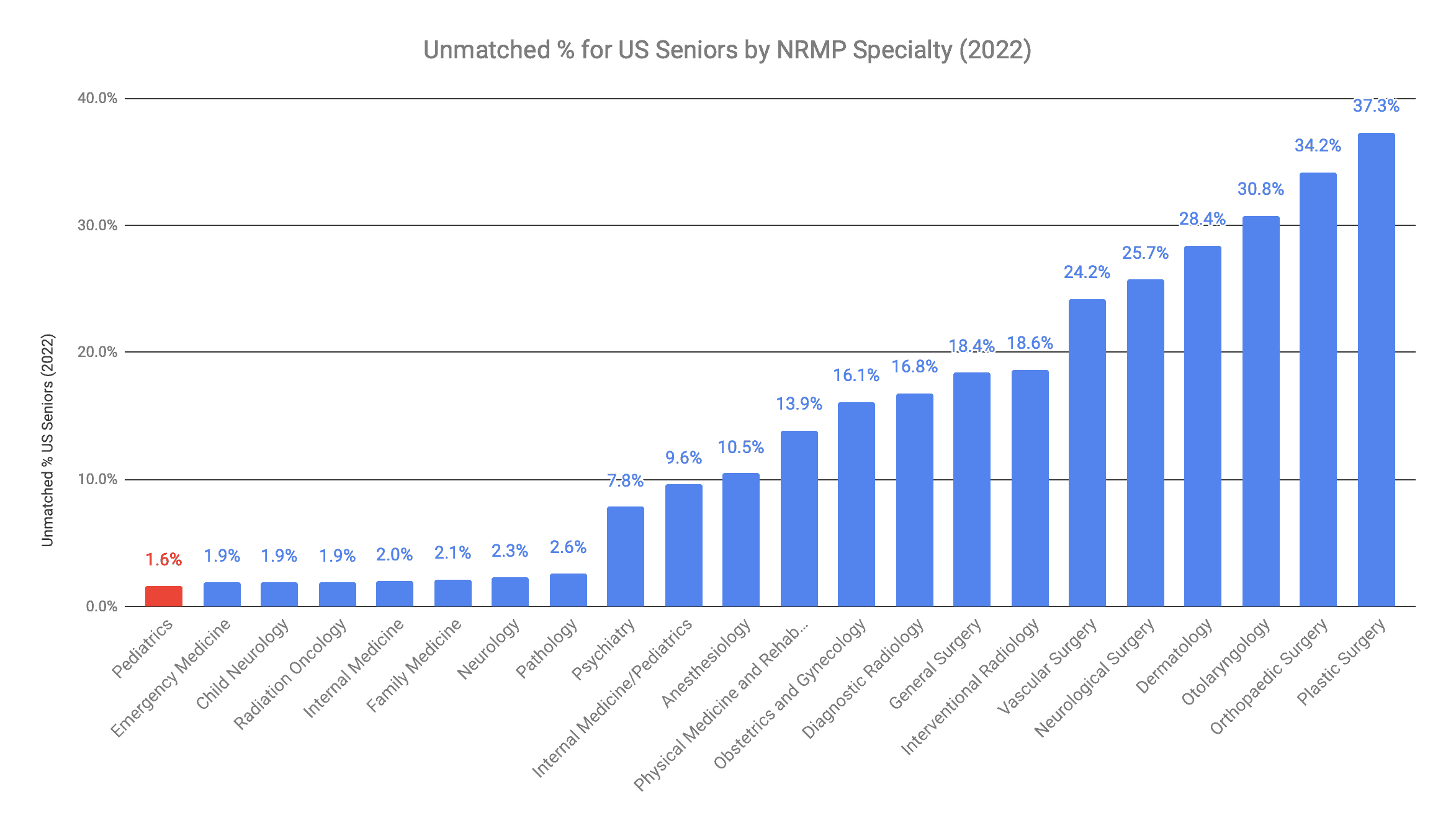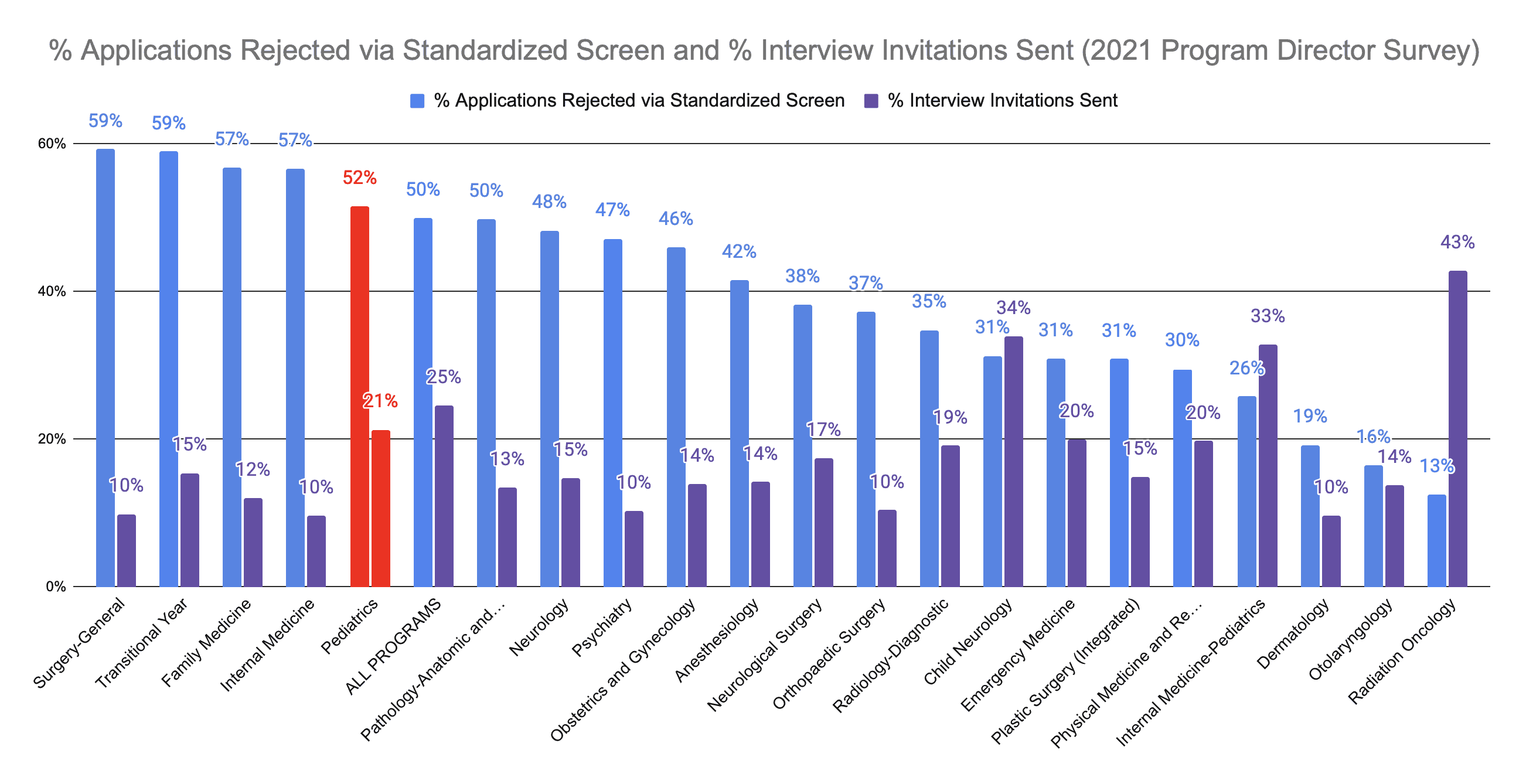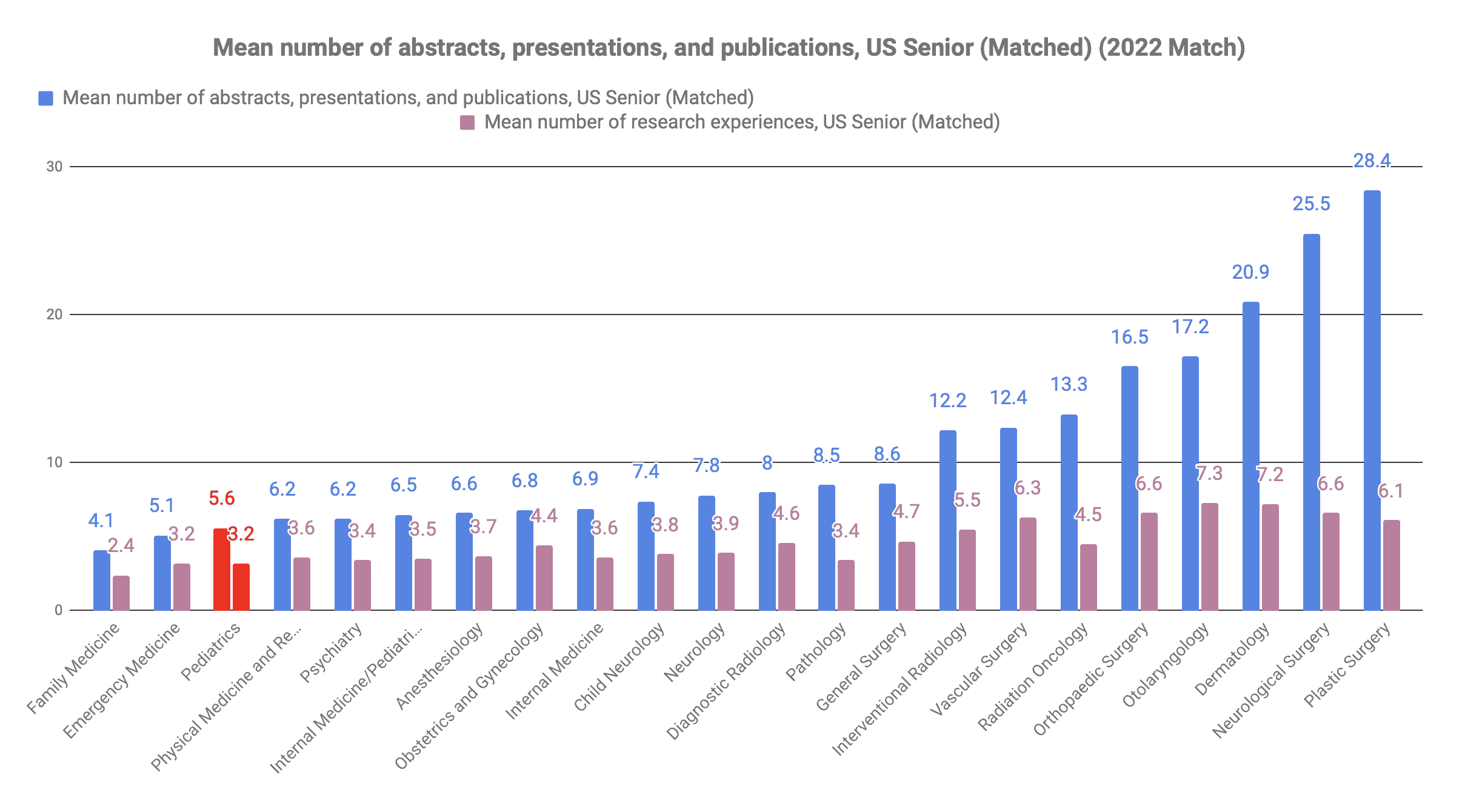
Is pediatrics competitive? How important are the USMLEs, research, med school reputation, and AOA membership for matching into pediatrics? Is pediatrics IMG-friendly? And what is the DO match rate for pediatric programs?
In this article, you’ll learn everything about pediatric’s competitiveness in 2022. In the process, you’ll learn what to focus on – and what not to – to maximize your chances of matching into this desirable specialty.
Summary:
- Pediatrics Overall Competitiveness: Low
- Research Importance: Low
- USMLE Importance: Moderate
- Importance of Attending Top 40 Med School: Low
- Importance of Class Rank / Obtaining AOA (Med School Honors): Low
Table of Contents
Is Pediatrics Competitive in 2022?
One way to assess the competitiveness of a specialty is to look at the match rate – the % of people who apply who end up matching into their preferred specialty.
Among US Seniors, the unmatched percentage was 1.6%, which makes it the least competitive US residency program. The match rate for pediatrics is significantly better than the most competitive specialties like plastic surgery, orthopedic surgery, or otolaryngology. Moreover, pediatrics had the highest match rate of all US residencies.
For more on the most competitive US specialties, see this article.
Pediatrics Match Rate
What is the pediatrics match rate for US seniors, DO seniors, and IMGs? The “match rate” is the % of people who applied to a particular specialty as their preferred specialty who successfully matched into the specialty.
- US Senior Pediatrics Match Rate (2022 Match): 98.4%
- DO Senior Pediatrics Match Rate (2022 Match): 97%
- US IMG Pediatrics Match Rate (2022 Match): 72%
- Non-US IMG Pediatrics Match Rate (2022 Match): 61%
See below for more on matching into Pediatrics as a DO or IMG.
Pediatrics Match Statistics 2022
In 2022, there were 3,016 pediatric positions available in the NRMP match. A total of 3,153 applicants listed it as their preferred specialty.
In the 2022 Match, pediatrics ranked #3 for most total positions offered, behind:
- Internal medicine: 9,809 positions
- Family medicine: 4,926 positions
How Many Applicants Receive Interviews in Pediatrics?
According to the 2021 Program Director survey, each pediatrics program received 1,018 applications on average. Other data include:
- Applications received (Pediatrics): 1,018
- Applications rejected based on standardized screen (Pediatrics): 525
- Applications receiving holistic review (Pediatrics): 454
- Interview invitations sent (Pediatrics): 217
- Applicants interviewed (Pediatrics): 185
- Applicants ranked (Pediatrics): 176
Looking at the percentages, we can see that for the 2021 Match:
- 52% of Pediatrics applications were rejected via standardized screen,
- Only 45% of Pediatrics applications received a holistic review,
- 21% of Pediatrics applications received an interview invitation, and
- 17% of all Pediatrics applicants were ranked to match
Pediatrics is Moderately Reliant on Screens
Pediatrics relies on standardized screens to weed out applicants. In the 2021 Program Director Survey, pediatric PDs respondents reported that 52% of applications were rejected via a standardized screen. As a result, this program ranks in the upper percentile of other residencies.
USMLE Scores for Pediatrics
Step 1 scores for pediatrics for matched US seniors reflect its moderate competitiveness.
Pediatrics Step 1 Scores (Matched Applicants in 2022 Match):
- 25%ile: 218
- Median: 231
- 75%ile: 243

Step 1 Pediatrics Scores Are Middle of the Road (2022 Match)
Similarly, Step 2 CK scores for pediatrics for matched US seniors reflect its moderate competitiveness.
Pediatrics Step 2 CK Scores (Matched Applicants in 2022 Match):
- 25%ile: 236
- Median: 246
- 75%ile: 256

Step 2 CK Pediatrics Scores Are Middle of the Road (2022 Match)
See this article for more on USMLE Step 1 and Step 2 CK percentiles for each specialty and the overall percentiles.
Matching into Pediatrics as a DO
Matching into Pediatrics as a DO is competitive, with a 97% match rate and 19% of spots filled by DO Seniors in the 2022 Match. In 2022, 585 DO seniors applied for Pediatrics; 565 matched.
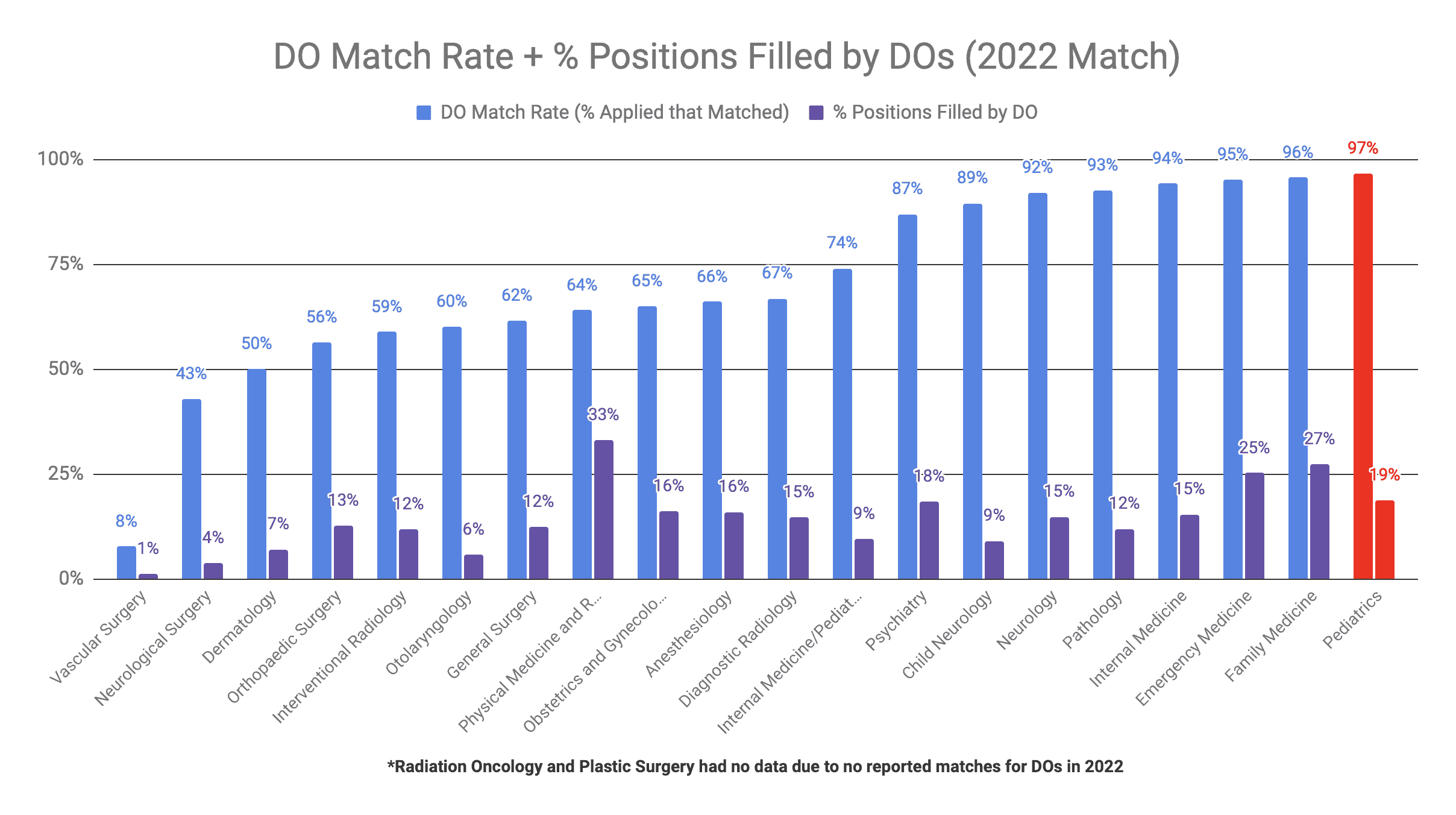
Pediatrics is DO-Friendly (2022 Match)
For more on the most DO-friendly specialties, see this article.
Is Pediatrics IMG Friendly?
Pediatrics is IMG-friendly, with an overall 65% match rate and 18% of spots filled by IMGs in the 2022 Match. In 2022, 290 US IMGs and 538 non-US IMGs applied to Pediatrics; 208 US IMGs and 328 non-US IMGs matched.

Pediatrics is IMG-Friendly (2022 Match)
We can see that US IMGs had a slightly higher match rate (72%) than non-US IMGs (61%) in Pediatrics.

For Pediatrics, US IMGs had a slightly higher match rate (72%) than non-US IMGs (61%) in the 2022 Match
For more on the most IMG-friendly specialties, see this article.
Pediatrics-Friendly IMG Residency Programs
For a list of the most IMG-friendly pediatrics programs, see this article.
How Much Do Pediatricians Make per Year? Per Hour?
Pediatricians have an average annual salary of $244,000. This can vary dramatically based on practice setting, specialty training, and experience level.
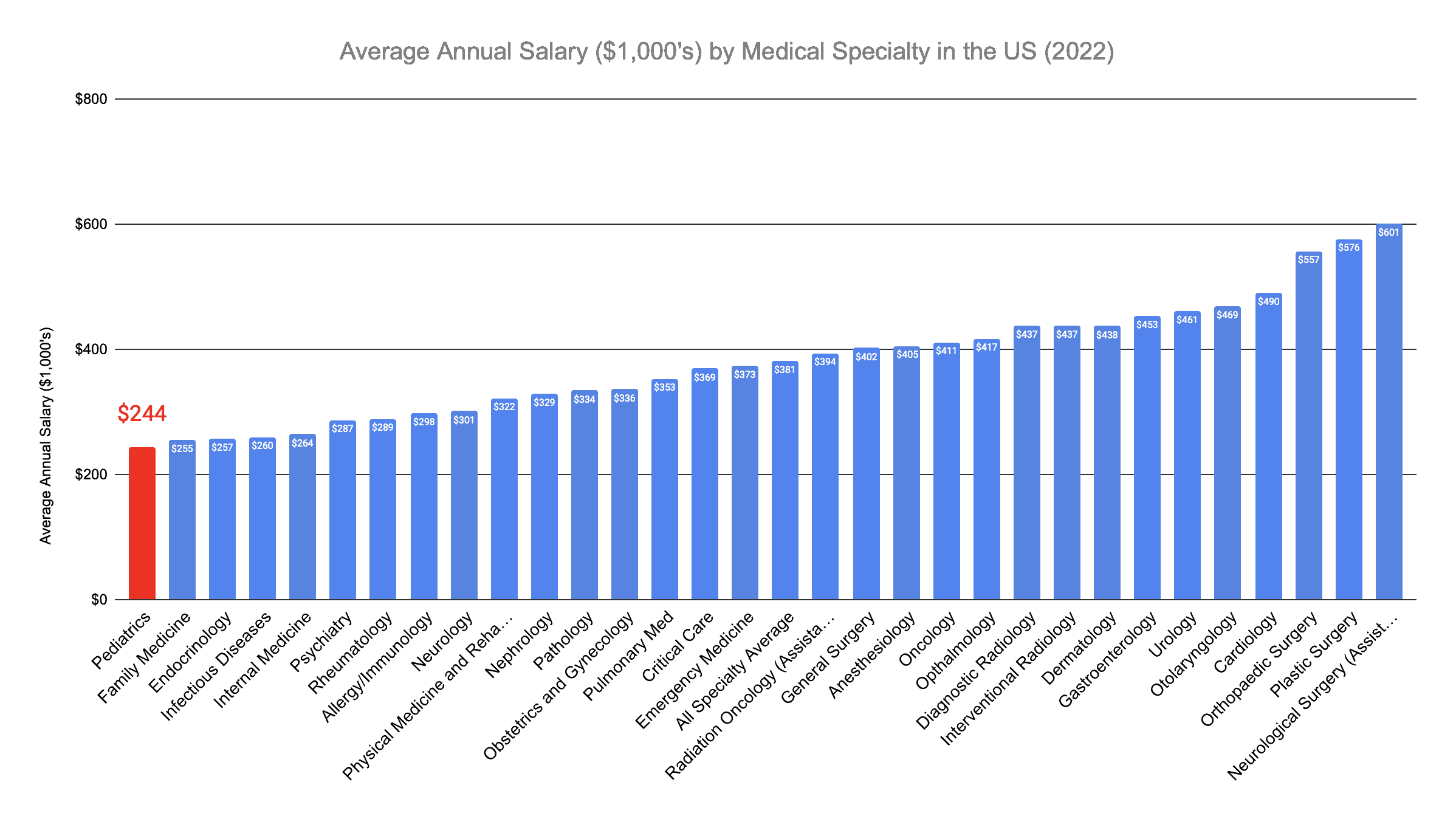
Pediatricians make $244,000 per year on average
However, annual salaries can be misleading. Some specialties work much more than others. By considering the estimated hours worked per year for pediatricians, we get an estimated hourly salary of $108/hr.

Pediatricians make roughly $108/hr on average when taking in hours worked per year
See this article for more on physician annual salaries and estimated hourly wage by specialty.
How Important is AOA for Pediatrics?
AOA – Alpha Omega Alpha – is the med school honors society. Each school may elect up to 20% of the graduating class of students.
Having an AOA membership confers a greater advantage to matching into some specialties more than others. Often this AOA advantage is greatest for the most competitive specialties.

AOA membership correlated with a 1% match rate advantage for Pediatrics in the 2022 Match
In the 2022 Match, the match rate for US seniors with AOA membership was 1% greater than that of US seniors without AOA membership. Membership in the AOA did not have an obvious advantage in matching into pediatric residency.
A number of schools do not have AOA chapters. Even in those schools, many of them rank students against each other. Regardless of AOA status, class rank is an important factor in successfully matching into pediatrics.
For more on AOA medical schools and the importance of class rank for matching, see this article.
How Many Publications for Pediatrics Residency in 2022
Research is an important characteristic for matching into many specialties, particularly the most competitive. So, how many publications do you need to match into a pediatric residency?
In 2022, the mean number of abstracts, presentations, and publications for US seniors who matched into pediatrics was 5.6. The mean number of research experiences was 3.2.
Do I Need an MD-PhD to Match Into Pediatrics?
You may wonder how much an MD-PhD helps with matching into pediatrics. It appears that having a PhD correlates with a modest advantage of -1% when applying to pediatrics. Specifically, the match rate for those with a PhD is 1% lower than for those without one when applying to pediatrics.
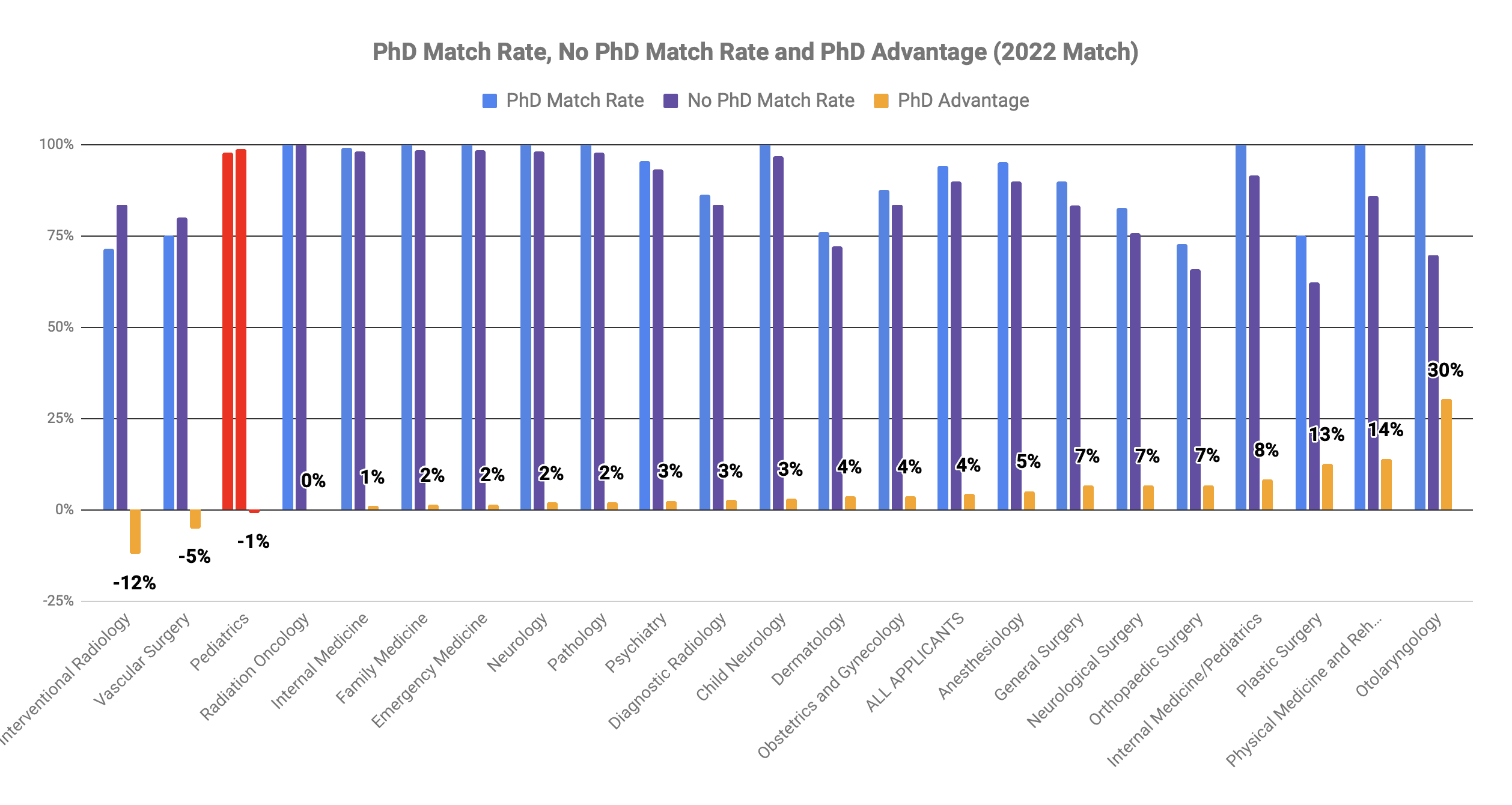
Having a PhD correlated with a -1% match rate advantage for Pediatrics in the 2022 Match
Note that those with PhDs are relatively rare among pediatric residents. In fact, only 3.5% of matched applicants into pediatrics had a PhD in 2022.

3.5% of matched applicants to Pediatrics had an MD-PhD in 2022
Should You Attend a Top Medical School to Match Into Pediatrics?
Does attending a top medical school help with matching into Pediatrics? According to the program director survey results above, 32.6% of Pediatrics PDs consider medical school reputation when considering whom to interview. The mean importance score was 3.3.
Similarly, we can look at the advantage of attending a school in the top 40 by NIH funding. In 2022, there was a 1% advantage in match rate for those attending a school in the top 40 for NIH funding vs. those who did not.
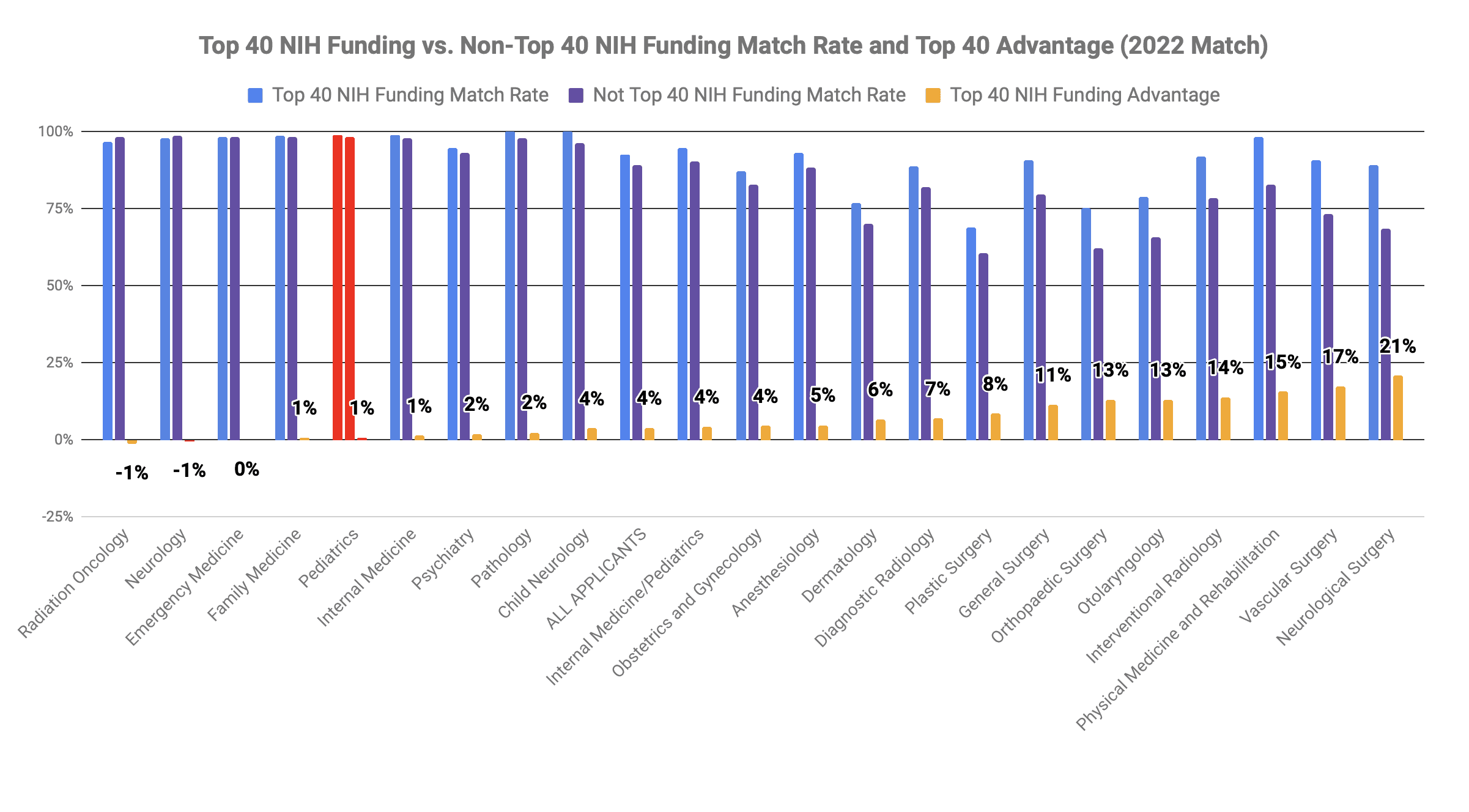
Graduating from a medical school ranked in the top 40 by NIH funding correlated with a 1% match rate advantage for Pediatrics in the 2022 Match
Does an MPH or MBA Help Match Into Pediatrics?
Medical training is long. Despite this, many consider – or complete – other degrees, like MPHs or MBAs.
But how much of an advantage – or disadvantage – does an MPH (Master of Public Health) or MBA (Master of Business Administration) confer when applying to pediatrics? Not much, it turns out. In fact, the match rate for US seniors with other degrees was 2% lower than the rate for those with other degrees.
These statistics imply that having a second degree that isn’t a PhD doesn’t appear to help your chances of matching into pediatrics, and may even hurt them (slightly).
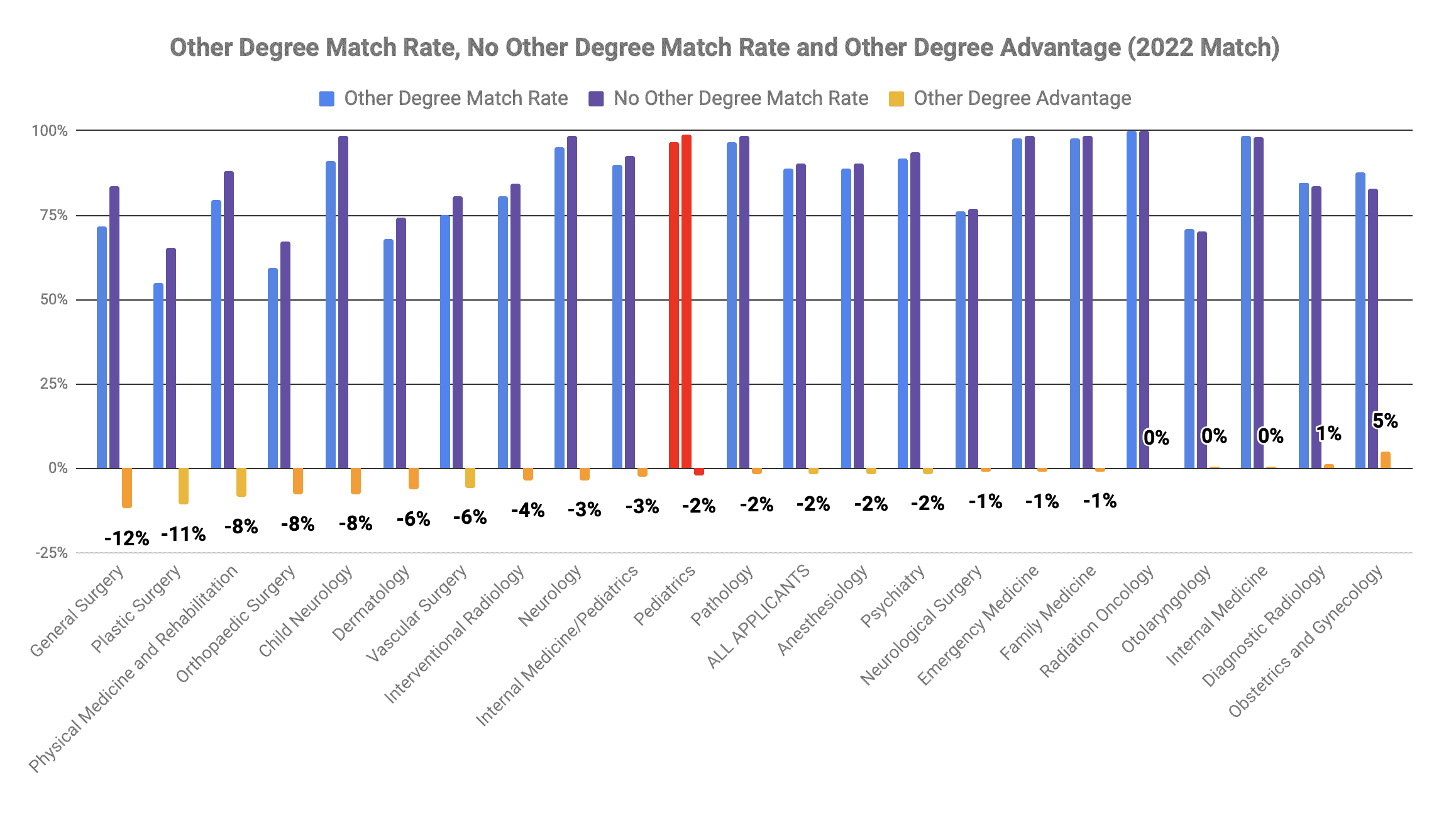
Having another degree like an MBA or MPH correlated with a -2% match rate disadvantage for Pediatrics in the 2022 Match
What Are the Best Pediatrics Programs?
While pediatrics may be moderately competitive, the most desirable programs will always be extremely difficult to enter. So which are the best pediatric residency programs?
Opinions will vary. However, some of the most desirable pediatric residency programs would include:
- University of Pennsylvania (Perelman)
- Harvard University
- University of Cincinnati
- Johns Hopkins University
- University of California – San Francisco
- University of Washington
Concluding Thoughts
So how competitive is pediatrics in 2022? Based on the statistics, the specialty isn’t highly competitive as compared to plastic surgery or orthopedic surgery. It also doesn’t require intensive research or extra credentials like an AOA membership or an Ivy League education.
That said, pediatrics can still be competitive, particularly for the most desirable programs. While it is true for all specialties, USMLE scores – and particularly Step 2 CK – will be emphasized moving forward, particularly given how reliant pediatrics is on standardized screens to weed out applicants.
To learn more about how to master – not memorize – for impressive USMLE scores and higher class rankings, sign up for a free consultation. You can learn more about how Yousmle can help you to make the most of your time, to excel in your classes, Board exams, and the extracurriculars that are critical to matching.
Looking for a Pediatrics Residency Advisor?
Looking for a pediatrics residency advisor? Want help writing your personal statement? Need effective strategies for interviewing? Do you have things on your application – e.g., low USMLE scores, failed USMLEs, no research, IMG status, or others – you need help overcoming?
Be sure to check out our Residency Advisor service.

